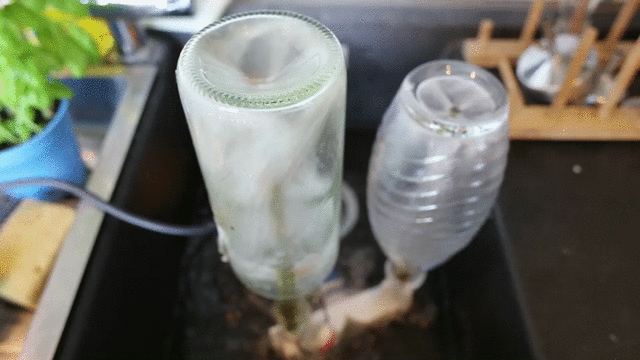Introduction
For quite some time I have been annoyed by the fact that it takes a lot of effort to clean bottles. In the dishwasher they do not get properly clean or deposits form in them. To rinse the bottles constantly by hand with glass beads or rice takes me too long. So I had to build it myself again.
The cleaning principle is copied from typical laboratory dishwashers for biological and wet chemical laboratories. Similar to household appliances, these devices have drawers in which, for example, spatulas or dissecting instruments can be rinsed. In other exchangeable drawers, tubes are arranged vertically onto which the bottles to be cleaned are placed upside down. This system is established and works very well.
My cleaning setup
It was important to me that the rinse water (like in a dishwasher) is used again and again. Therefore, connecting the bottle washer directly to the water tap was out of the question for me.
I opted for a pump with a high pumping capacity that still has compact dimensions to fit in my sink. For safety reasons, a 12 V DC system was important to me. In addition, it was convenient for me that such a pump can be easily controlled with a PWM. I chose the cheap bilge pump BL2512J also sold under the designation BL-2512SI. The flow rate is slightly oversized at 70 L/min (the bottles are supposed to get clean). I connected the pump with a short piece of hose (diameter 25 mm) with the actual flushing unit.
This is printed from more heat-resistant PETG to withstand temperatures up to 60 °C. The water jet is split here and directed into two pipes. The openings for the pipes are a bit too small. To insert the tubes, they are heated (I used a flamer) and mozlen directly into the openings. This results in a stable and tight connection. When melting the tubes, be careful not to bend them back and forth too much. otherwise, the holes will stretch too much and the connection will no longer be tight.
I have used brass tubes with a diameter of 8 mm and a length of 200 mm. To achieve a good cleaning effect, the tubes must be slit crosswise at the upper opening lengthwise approx. 10 mm. This is best done with a dremel (or similar).
The strong reduction of the pipe diameter from 25 mm at the pump to 7 mm at the pipes leads to an increase of the flow velocity (continuity equation) from initially 23.8 m/s at 42 m³/h to an outflow velocity at the nozzle of 75.8 m/s.
v_2=\frac{v_1A_1}{A_2}I used a Mean Well LRS-100 12 with 102 Watt as power supply and designed and printed a suitable case for it.
When cleaning, make sure that the pump is not a dirty water pump. The bottles must therefore be roughly pre-cleaned. Bottles made of heat-sensitive pressed glass will burst immediately if warm water is flushed through them directly.












